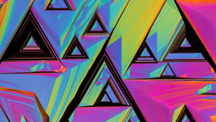Sapphires with Unusual Radial “Eye” Structure
The Luc Yen district in northern Vietnam produces some remarkable stone varieties, including ruby and red and cobalt-blue spinel. Recently, Geir Atle Gussiås of BalderGems in Luc Yen procured some interesting sapphires from local gem traders. These stones exhibited a radial pattern often accompanied by concentric color zoning. This pattern is commonly seen in minerals that precipitate from fluids such as carbonates and cryptocrystalline silica varieties, but to our knowledge it has never been observed in corundum. All of Gussiås’s samples were opaque and cut as cabochons to display this strange growth pattern. Due to their distinctive appearance, these gems have been called “eye sapphires” in the trade (see figure 1).
The patterns exhibited different forms and sizes but were always a combination of blue and white, with a lower polish quality in the white areas. Raman spectroscopy confirmed that both the white and blue areas were corundum, but the presence of diaspore was detected only in the whiter areas. Some areas also showed a mottled texture and small unidentified black inclusions (figure 2). Laser ablation–inductively coupled plasma–mass spectrometry (LA-ICP-MS) analysis of the sapphire in figure 1 revealed a low iron content, which excludes a basalt-related origin. Epigenetic yellow goethite was found in several fractures on the top of the cabochon. The presence of this mineral was evidence that the stone had not been heat treated (figure 3): Goethite, an iron hydroxide mineral, alters to rust-colored hematite at relatively low temperatures (J.I. Koivula, “Useful visual clue indicating corundum heat treatment,” Fall 2013 G&G, pp. 160–161). Corundum heat treatments have been performed for centuries and are widely accepted in the trade, but this stone needed no extra enhancement beyond cutting and polishing to reveal its anomalous beauty.
While the cause of this unusual radial aggregate structure remains unknown, it is certainly a welcome novelty in the collector gem market.



